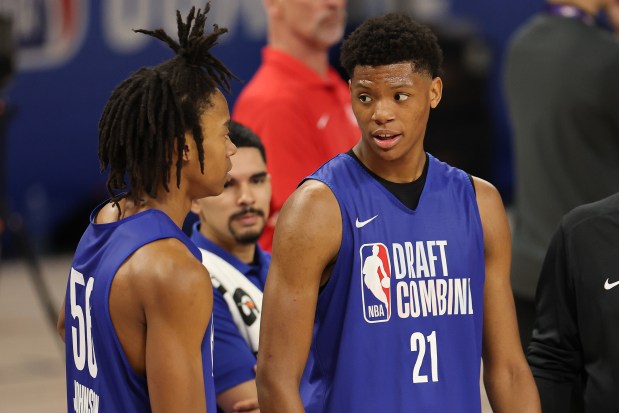In the first five weeks of the WNBA season, Chicago Sky fans posed one question: why isn’t Chennedy Carter starting?
The fourth-year guard drew immediate attention in her first 12 games, averaging 12.9 points and 2.3 assists in just under 20 minutes off the bench. When the Sky sank into mid-game lulls, Carter could be counted on to poke away errant passes and reignite the offense with breakneck transition plays. And as the team struggled with increasingly stagnant starts – lowlighted by a 10-point first quarter against the Washington Mystics – the question built into a clamor as Carter remained a bench player.
Coach Teresa Weatherspoon answered that call this weekend, moving Carter and guard Lindsay Allen into the starting lineup to replace guard Dana Evans and wing Diamond DeShields in Sunday’s game against the Indiana Fever. And despite dropping another game in Indianapolis, the shift made a clear impact on the Sky’s tempo from the opening whistle.
So is this new starting rotation the balm the 4-9 Sky have been looking for?
After drafting Kamilla Cardoso and Angel Reese, the Sky are clearly building for their future with the frontcourt as their foundation. General manager Jeff Pagliocca made it clear on draft day that this will require at least one season of development as both players transition to the league and develop key parts of their game, such as outside shooting.
But the backcourt is a different problem, one that goes beyond simple player development. The Sky have the worst assist ratio (16.4) and 3-point shooting production (4.5 per game) in the league. As a result, the guards often sink into static half-court offense and struggle to consistently find Reese and Cardoso with entry passes.
Carter’s move into the starting lineup was a promising improvement — she replicated her scoring production, boosting the offense with 18 points and four assists. The Sky also benefited from the presence of Allen, who settled the offense at point guard despite an off-kilter performance from both rookie bigs.
But the loss to the Fever also highlighted why giving Carter more minutes isn’t the end-all answer. Despite her consistent scoring, Carter has her own limitations. She does not take threes, averaging 0.5 attempts per game (the lowest of any guard) from behind the arc. And at 5-foot-9, moving Carter onto the wing vastly decreases the height of the starting unit, creating an automatic mismatch in plenty of defensive matchups.
Even with this week’s changes, a rotational shift won’t be enough to fully overhaul the position group. After shuffling up roster spots, the Sky are still clearly missing several starter-quality pieces — namely a point guard or a lengthy wing. And that means Weatherspoon and Pagliocca will need to dig deeper for solutions, both this year and in the offseason.
Before anyone starts campaigning for the Sky to solve their guard problem by tanking to snatch up Paige Bueckers in the 2025 draft, that’s not an option. The Sky already agreed to a first-round pick swap with the Dallas Wings, which means they have no chance of landing the No. 1 pick outside of a blockbuster trade.
So with that off the table, how can the Sky improve their backcourt?
Facilitation is a key issue. The Sky’s best guards — Carter and Marina Mabrey – operate best off the ball. Carter is lethal in transition while Mabrey has flexed a variety of looks, including post-ups to create shooting opportunities. But neither player is expected to operate as a primary distributor for their teammates.
The Sky haven’t fielded a natural point guard since the exit of Courtney Vandersloot after the 2022 season. Evans was supposed to fill this role after waiting three seasons for her opportunity, but this is the second consecutive season in which she failed to defend her starting role. Last year, former coach James Wade elected to convert Courtney Williams into a point guard midseason rather than start Evans. This season, Weatherspoon gave Evans 12 games in the starting gig before replacing her with Allen.
A true point guard is a slowly fading facet of a WNBA offense as many teams rely on hybrid guards. For instance, the Connecticut Sun run their backcourt by committee with forward DeWanna Bonner providing a healthy dose of ball progression and distribution. But the Sky currently lack the versatility of size and shooting to compete in this style of play.
The remaining backcourt players lack one of two qualities: size or shooting. DeShields brings the length and defensive acumen the Sky crave on the perimeter, but nagging injuries continue to limit her scoring and availability. Players like Allen similarly struggle with offensive production, while the size disadvantages of Evans and Carter stiffle their ability to share the court.
Sunday’s improvements illustrated a clear formula for how to build success in the Sky backcourt: improve ball distribution into the paint, let the bigs go to work and capitalize on the spray-out, catch-and-shoot opportunities behind the arc that are certain to follow. But the deficiencies are clearly too large for a few in-season adjustments to correct.
As the front office aims to build around Cardoso and Reese, the next priority is simple: provide this frontcourt duo with the backcourt balance necessary to begin stacking winning seasons.




